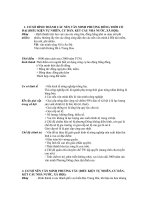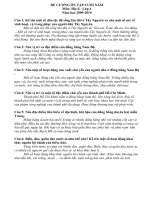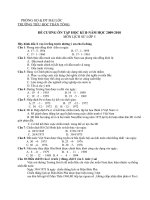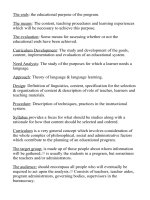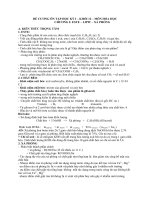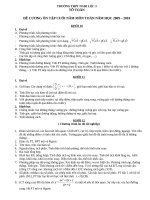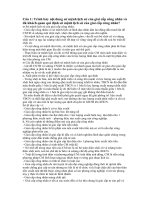Đề cương ôn tập cuối kì môn chương trình phát triển tiếng anh
Bạn đang xem bản rút gọn của tài liệu. Xem và tải ngay bản đầy đủ của tài liệu tại đây (56.01 KB, 4 trang )
The ends: the educational purpose of the program.
The means: The content, teaching procedures and learning experiences
which will be necessary to achieve this purpose.
The evaluation: Some means for assessing whether or not the
educational ends have been achieved.
Curriculum Development: The study and development of the goals,
content, implementation and evaluation of an educational system.
Need Analysis: The study of the purposes for which a learner needs a
language.
Approach: Theory of language & language learning.
Design: Definition of linguistics, content, specification for the selection
& organization of content & description of role of teacher, learners and
teaching materials.
Procedure: Description of techniques, practices in the instructional
system.
Syllabus provides a focus for what should be studies along with a
rationale for how that content should be selected and ordered.
Curriculum is a very general concept which involves consideration of
the whole complex of philosophical, social and administrative factors
which contribute to the planning of an educational program.
The target group: is made up of those people about whom information
will be gathered./// is usually the students in a program, but sometimes
the teachers and/or administrators.
The audience: should encompass all people who will eventually be
required to act upon the analysis./// Consists of teachers, teacher aides,
program administrators, governing bodies, supervisors in the
bureaucracy.
The needs analysts: may be consultants brought in for the purpose or
members of the faculty designated for the job/// are those persons
responsible for conducting the needs analysis/// outsiders (future
employers or professors from the students’ content courses).
The resource group: parents, financial sponsors, or guardians/// experts
in the field/// consists of any people who may serve as sources of
information about the target group.
Approaches: theoretical motivations underlying any curriculum
development (Anthony 1963; Richards & Rogers 1982; McKay
1978)///// ways of defining what the students needs to learn based on
assumptions and theoretical positions drawn from disciplines as diverse
as linguistics, psychology, and education.///// the classical approach, the
grammar-translation approach, the direct approach, the audiolingual
approach, the communicative approach.
Syllabuses: examining instructional objectives, arranging them in terms
of priorities, and then determining what kinds of techniques and
exercises are required to attain those objectives.///// the choices
necessary to organize the language content of a program.///// Structural
– Situational – Topical – Functional – Skill-based…; Task-based;…
Techniques: typically includes various combinations of interactions
between teacher and student, ss – ss, cassette player & ss ///// set of
activities/ways of presenting language points to the students.
Exercises: set of activities/ways of having the students practice
language points they have been presented.///// centers on students using
the language in some interaction such as Ss-Ss, Ss-T, Ss- group.
The level of specificity is the single-most-distinguishing characteristic
between goals and objectives.
Discrepancy philosophy is one in which needs are viewed as differences
between a desired performance from the students and what they are
actually doing.
In the analytic philosophy a need is whatever the students will naturally
learn next based on what is known about them and the learning
processes.
A diagnostic philosophy proposes that a need is anything that would
prove harmful if it is missing.
Needs related to the program’s human aspects (the physical, social, and
psychological contexts) are labeled situation needs.
Language needs are generally more difficult to determine because they
have to do with “wants,” “desire,” and expectations” (Brindley 1984,
p.31).
Questions of priority investigate which topics, language uses, skills, and
so on are considered most important for the target group to learn.
Attitude questions are created to uncover information about participants’
feelings toward elements of the program.
Existing information can include data sources within a program (files or
records), or external data sourses.
A case study is to record the linguistic chacteristics or behaviors of a
selected individual or several individuals.
The delphi technique is a meeting, or series of meetings, in which the
task to be performed is reaching a consensus.
Reliability is the consistency with which a procedure obtains
information. Any procedure – whether it be a ruler of measuring length,
a scale for determining weight, or a questionnair for astertaining
attitudes – should obtain approximately the same results every time it is
used to measure the same person or object.
According to Bloom’s Taxonomy, the cognitive domain refers to those
aspects of learning that are related to feelings, emotions, degrees of
acception, values, biases, and so forth.
Consistent instruction is the results of the learning process in a program
shoul be consistent over time and between sections of the same course.
Product-oriented approach: the focus of the eveluation is on the goals
and instructional objectives with the purpose of determining whether
they have been achieved.
Static-characteristic approach: this type of eveluation is conducted by
outside experts who inspect a program by examining various accounting
and academic records.
Formative evaluation take place during the ongoing curriculum
development processes. The aim of this type of evaluation is to collect
and analyze information that will help in improving the curriculum.
Quanlitive data consist of more holistic information based on
observations that may not readily lend themselves to conversion into
quantities or numbers.
Choose the best component to describe the underlined part in the
following instructional objective as indecated by Mager (1975, p. 23).
“By the end of the course, the students will be able to write to full forms
of selected abbreviation drawn from page 6-8 of the course textbook
with 80 percent accuracy.” === conditions
Choose the best component to describe the underlined part in the
following instructional objective as indecated by James Dean Brown.
“Given a sentence written in the past or present tense, the student will
be able to use the future tense to rewrite the sentence with no errors in
tense and no tense contradiction.” ==== criterion
